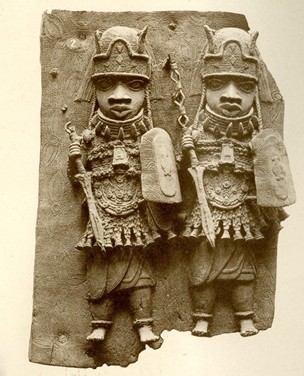For over 700 years, the Benin art and history has been a subject of fascination, mystery and intrigue. This tale of imperial history and heritage has brought the world to its knees with respect and admiration.

But how did this all start? How did civilisation and art journey into the heart of the Benin Empire at its prime?
Way before Nigeria was a country or the continent was called “Africa”, the Benin Empire stood tall in its glory and wealth. History attributes the Benin civilisation to the early visit of the Portuguese in 1485 when it berthed its ship on the shores of the Benin River. But even that does not accurately give explanations of how the Empire was developed.
Historical reports and writings of Olfert Dapper, a Dutch traveller and writer, in 1668, gave actual recordings of an empire that had far more advanced civilisation and technology as far back as the 15th century. Early recordings of street lights, a well-planned city structure, commercial and trade-craft that supplant even the Roman and Chinese dynasty were highlighted.

The Empire boasts of great agricultural products and exotic animals in the forest. The great Oba (Ekpen’owa or the home leopard) rules at the helm of its affairs, a demi-god in his own right. But the 15th century ushered in the change that would reform the Benin Empire forever.
In 1555, Oba Esigie lost his beloved mother, advisor, the commander of the Benin Army and his spiritual guide, Queen Mother Idia, the hidden Oba of Benin and ruler of Uselu. Bereaved of his mother’s demise, he commissioned the royal carvers at the Palace to create a bronze piece that would live on forever in her place. The bronze carved figurine would later be the official symbol for the FESTAC 1977 Festival.

This single act placed the Benin arts in the limelight. For centuries, Benin saw a surfeit of bronze art and carvings, depicting exploits and narratives that would make its art the cynosure of global attention. Its heritage and culture lived in the arts for the next thousand years, telling the story of a great empire that had developed a regenerating cycle of life for itself in its art.
The only physical evidence of how great and mighty the Benin Empire was at its peak was seen in the bronze artworks commissioned to tell the stories of the Benin people. What made the Benin art a universal vessel of cultural heritage wasn’t the art itself but the extent of detailing seen in the artworks. The quality and outstanding artistic expression imprinted on each art piece made it enviable to the outside world.

The Empire was at the centre of global attention in 1897 when it was invaded by the British Naval forces. The great Oba Ovonramwen N’ogbaisi was exiled to Calabar. The priceless artworks were looted and taken to cultural institutions around the world like the British Museum, where they are displayed.
Despite attempts by Nigerian authorities and traditional elders to return them home, the artworks remain unmoved. Now, 120 years after its theft, the British Museum has offered to return it to its home on a loan.
The Benin art will still be around for the next thousands of years. Nations and people will fade into dust but the Benin art will gloriously live forever.
[ad unit=2]








